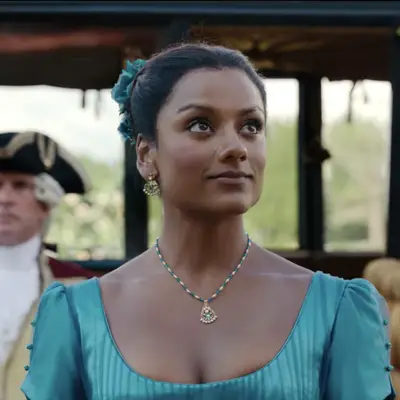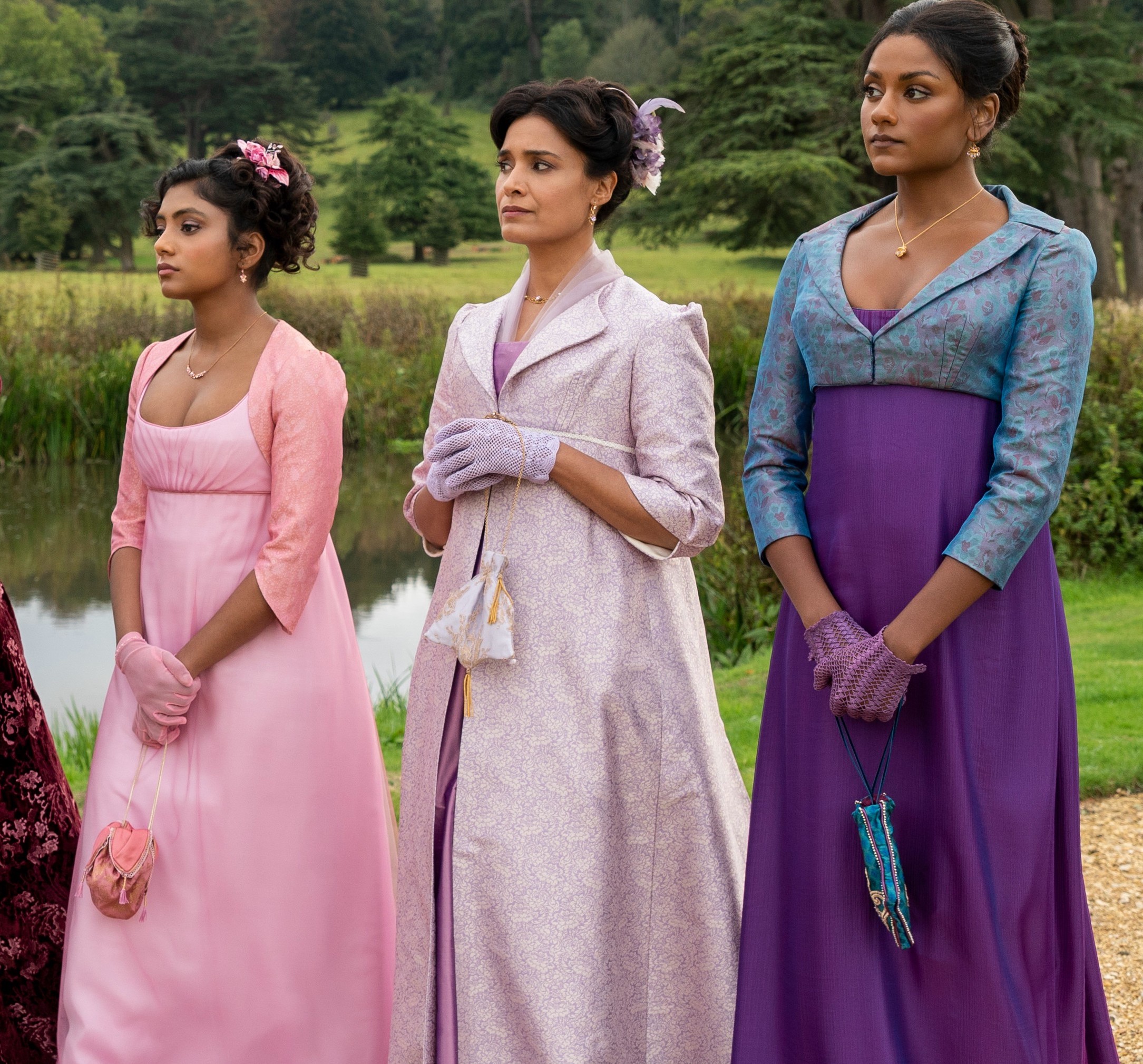Dearest Reader,
Bridgerton Season 2 won the hearts of many South-Asian individuals with its natural inclusion of South-Asian culture and representation. As a desi woman, it’s fair to say the subtle moments sprinkled throughout the season nearly brought tears to my eyes from its beauty and accuracy.
The Sharma women brought their characters to life while staying true to their heritage and culture. So from this desi girl, the one who used to wear a lehenga and cry while wearing bangles because they were oh so itchy, thank you. Thank you to the Sharmas for bringing to life strong desi women. Thank you for bringing to life little girl dreams of seeing South-Asian princesses, countesses, ladies, and regency heroines on our screen. Thank you for being thoughtful in the portrayal and including accuracy without stereotypes.
Thank you to the Sharma Ladies.
LANGUAGE
From the minute Kathani Sharma said “baap re,” I knew I would love her. Baap re is a Hindi expression that conveys astonishment, positive or negative, and replaces “omg.” Kate Sharma’s reflexive use of Hindi proves how multifaceted bilingual people are. Even if we spend years, months, or weeks speaking one language, if we have another language in our arsenal, we process scenes so fast that we may use another language reflexively.
This season never shied away from the use of Hindi and Tamil. For example, Edwina repeatedly addresses Kate as “didi” throughout the season. Didi is the Hindi word for sister. In the South-Asian culture, we refer to many family members with respectful terms of endearment, not usually first names. Again, we see this when Kate and Edwina refer to their parents using “appa,” “amma,” and Kate using “mamma” for Lady Mary.
Besides the actual use of Hindi and Tamil, the characters pronounced certain words PROPERLY, which is a huge win. There was no anglicized accent when speaking Hindi and Tamil, and all words were pronounced with the proper articulation. Even Anthony Bridgerton pronounces “Kathani” correctly without any anglicism. Other properly pronounced words, such as “sitar” and “maruli,” brought joy to me as proper pronunciation is key to respecting a culture, even from the people of that culture.
When Kate talks about the different languages Edwina speaks, we learn she can speak Marathi and Hindustani. Hindustani is a combination of modern standard Hindi and modern standard Urdu, and we know they use those languages amongst the season. I know it’s the little things, but Kate’s pronunciation of Marathi and Hindustani fully articulated every syllable, and as a desi girl, it proves to me the show’s respect for the culture by getting the pronunciation right.
STYLING





You are right if you noticed a difference between the Sharmas’ styling and the other ton members. The Sharmas’ dresses have intricate beading, representing traditional and formal desi lehengas and saris. We also see Kate sporting a thin piece of fabric around her arms, representing the scarf that usually pairs with traditional desi gowns. We refer to this scarf as a “dupatta,” like a shawl.
Beyond the detailed beading, many fabrics are South-Asian inspired, seen through the embroidery, patterns, and colors. While Edwina looked beautiful in pink, we saw Kate with an array of peacock blues, deep oranges, and rich purples. Fortunately, Kate was never one to embrace the ton’s demured color scheme.
Other traditional pieces of styling throughout the season included jewelry. The jewelry pieces included many intricate golds, greens, and ruby reds, including Kate’s bangles in the sixth episode. The jewelry itself was traditional, as seen through the drop earrings, which came in various designs such as “jhumka” and “chandbali.” These styles usually include many raindrop-like pearls and beading and come in a matching set with a necklace.
The styling was quintessential for the part, and I cannot thank the crew enough for getting it right. Even though they blend into the ton, they still stay true to their traditional style. The choice to properly represent the characters and their heritage warms my heart because it proves that the diverse casting choices weren’t performative. They went beyond just hiring a diverse cast and calling it a day. They chose to distinguish the cultures they were working with properly, and naturally, too.
CHAI



Now, who starts off the day with anything less than a good cup of strong chai? And no, it’s not called “chai tea” because you’re essentially just saying “tea tea.” It’s just called chai. Chai is different from English tea because it has various spices, so we refer to it as “masala chai.” Masala is a mixture of ground spices and herbs.
Of course, as we know, Kate prefers chai over English tea any day; and honestly, who can blame her? So, we see Kate start her morning at Aubrey Hall with a cup of warm chai as she brings the spices with her. Also, that bag that she has the spices in? Yeah, I have about four of those laying at home for various uses.
Chai is a common tradition in South-Asian culture. Every person you invite to your home, you will offer them chai. Every time you get sick, some elder will offer to make you an extra-strong cup of chai. It’s your morning kickstart and end-of-the-day winddown. Chai is a time to sit down together and talk or relax and be with yourself. It warms the body and soul, and it just tastes fantastic.
OIL


Watching Bridgerton at 6:00 am on no sleep comes with a range of emotions. One of those is tear brimming joy, like when I saw this scene. The scene of Kate oiling Edwina’s hair is so personal to many South-Asian individuals. This scene made me tear up at how naturally such a simple cultural act is part of the show. It may have also made me tear up because I forgot to oil my hair that week. Anyway, moving on.
So many South-Asian kids have fond memories of sitting at the feet of their elders while they massage warm oil into their scalp to ensure that our hair grows as luxuriously as it can. It bonded many of us to our elders and family because it was just tradition. Then, when we grew up, we either forgot or oiled our own hair, but nothing matches that feeling of having someone else oil your hair.
I still oil my hair once a week because it is restorative and regenerative for the scalp, and because my grandma is still around, I keep her in practice. So, it’s just a habit, routine, tradition, whatever you want to call it that stuck—seeing that the desi culture and a bonding moment between sisters encompass everything that that act is meant to be.
HALDI CEREMONY


THIS SCENE. If I was tearing up earlier, I was full-on crying now. This scene brings me back to weddings in my family. The flower garlands in the back? I have at least 20 of those garlands sitting in a box at home. We decorated our house with those garlands, and the bride would occasionally wear a long yellow dress before her wedding. It just brought together joy and family.
Now the Haldi ceremony is a ritual for many Indian families, and this ceremony does differ across the South-Asian culture. It can differ because of religion or because of locale. In my family, we don’t do a ceremony due to religious differences, but the bride did make a face mask because all South-Asian families know that Haldi is an herb that is naturally healing and therapeutic. You can find it in many South-Asian dishes, in chai, and as great skincare.
The Haldi ceremony is a ceremony in which family members rub a turmeric paste on the bride and groom in the hope of protecting and beautifying them. That is why Edwina asked if Anthony should be joining them. It’s a vibrant, fun tradition, and the beauty of this scene was that it just became a part of the scene—no explanation, just natural and seamless.
We can’t forget the iconic song behind this scene now, can we K3G fans? Yup! The soundtrack included a violin cover of Khabi Khushi Khabi Gham, and for anyone who hasn’t seen that movie (yes, it’s the name of the song and the movie), it’s the one where everyone has a crush on Sharukh Khan and where Hrithik Roshan cries every ten minutes. But, I mean, could more songs have been added? Yeh Ladka Hai Allah could have fit well when Kate drops the bangle ’cause we all remember that scene where Kajol’s bracelet gets stuck in SK’s cuff link, but hey… at least we got one.
The scene was brought into the show in a light, bubbly, familial way. It existed in its entirety and brought no shortage of tears because of its accurate representation. There was no single anglicized portion from the song, to the scenery, to the actual ceremony. Everything was faithful to the South-Asian culture, and for that, I thank the Sharma Ladies. It wasn’t reduced or whitewashed; it was full and vibrant.
THANK YOU
While representation still has a long way to go, and it may not have been perfect, every South-Asian individual has always wanted to see someone who looks like us, talks like us, acts like us, and embraces our culture in Hollywood. We want to enjoy our food, clothes, and music on mainstream TV and proudly say, “Yes, this is what we do.” Every little girl wants to see a princess, lead, or hero who not only looks like her but, more importantly, embraces her culture. Every boy wants to see a hero with their culture. Every person wants to see themselves expressed in entertainment. The Sharma Ladies gave us that.
They were unapologetic, strong, and of genteel manners. They sacrificed more for each other than some families could even imagine. They reminded me of why I loved taking my favorite desi food to school, why I love oiling my hair, why chai is the most important meal of the day (especially in uni), why those heavy, back-breaking dresses are perfect, and why I love my culture. They reminded me that my culture is born of family and joy, and there is nothing more that matters to us.
The Sharma ladies’ portrayal was whole in culture and was rich in heritage. There was no whitewashing or exploiting traditions for white consumerism. There wasn’t the occasional line about butter chicken because the portrayal ascended the stereotypical little pieces and became a complete and accurate representation.
So, thank you. Thank you from this desi woman. Thank you for representing us correctly.
Regards,
This South-Asian Author
Bridgerton Season 2 is available to stream on Netflix.

